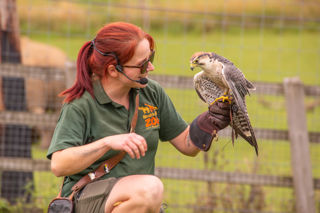
Six-banded Armadillo
Scientific name: Euphractus sexcinctus
There are 20 different species of armadillo, all except one are found in South America.
The six-banded armadillo derives its name from the six moveable bands found within its armour. This armour is formed from plates of bone, covered in scales made of Keratin. They are also referred to as the ‘yellow armadillo.’ Unlike other armadillos they are unable to roll into a ball, instead they will flee into burrows to escape predators.
They are usually a diurnal species of armadillo, being most active during the day. They will spend a lot of their time foraging for food or digging dens to sleep in, which can be up to 2 metres underground. They have poor eyesight and hearing, relying primarily on their sense of smell to survive and detect both prey and predators. The six-banded armadillo is primarily solitary (other than when mating) and will scent mark its territory in order to keep other armadillos away.

-
At Noah's Ark...
We have 2 Six-banded Armadillos... Arnold and Ernie.
-
We live...
In the Viva South America, opposite the Eagle and Vulture enclosures.
-
Size Fact
The six banded armadillo is the third largest armadillo species (after the giant armadillo and the greater long-nosed armadillo).
-
Food Fact
The six-banded armadillo is an omnivore. This means its diet is made up of a mixture of plant matter, such as fruits, leaves and roots, as well as small invertebrates and carrion.
-
Fun Fact
The term armadillo is Spanish and means ‘Little Armoured One’.

Adopt Me
You can support our conservation efforts and help with the costs of keeping rare and wonderful zoo animals by adopting an Armadillo. Adopt an Armadillo for yourself or as a gift.
You might also like...
-
![Meerkats]()
Meerkat Keeper Talk
Come along and learn about our mob of Meerkats from our experienced animal keepers.
Find out more
-
![Zoe And Falcon (2)]()
Bird of Prey Flying Display
Watch our majestic birds of prey in our new Wings of Wonder flying display.
Find out more
-
![Andean Bear]()
Bear Keeper Talk
Learn about our Spectacled bears from our experts and find out what it is like to be a Spectacled bear keeper.
Find out more
-
![African Elephant - Shaka 2]()
Elephant Keeper Talk
Did you know Elephants are the largest land animals on Earth? Come and join our Elephant Keepers and learn about our bulls.
Find out more

Sign Up to the newsletter
Would you like to receive marketing emails from us? Please tick the box if you would like to receive information about future events, ways you can support our charity, offers and discounts.





